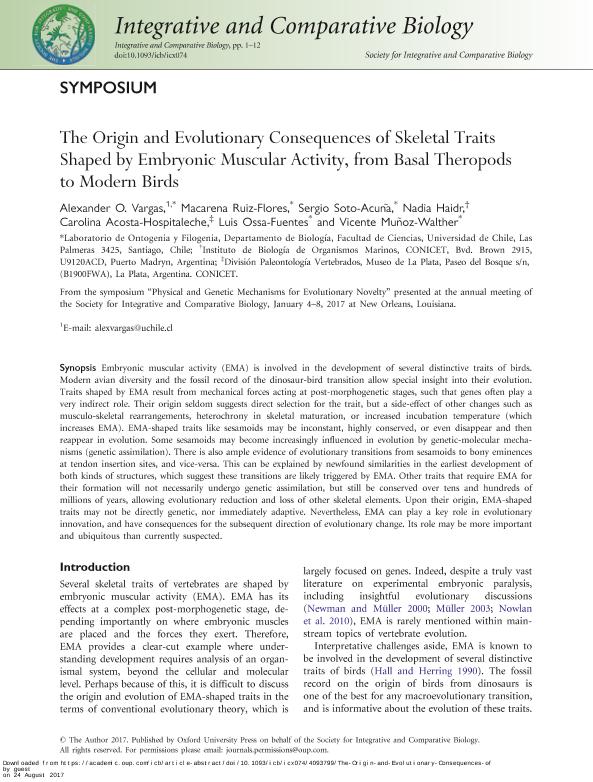Artículo
The Origin and Evolutionary Consequences of Skeletal Traits Shaped by Embryonic Muscular Activity, from Basal Theropods to Modern Birds
Vargas, Alexander O.; Ruiz Flores, Macarena; Soto Acuña, Sergio; Haidr, Nadia Soledad ; Acosta Hospitaleche, Carolina Ileana Alicia
; Acosta Hospitaleche, Carolina Ileana Alicia ; Ossa Fuentes, Luis Andrés; Aguayo Muñoz, José Fernando
; Ossa Fuentes, Luis Andrés; Aguayo Muñoz, José Fernando
 ; Acosta Hospitaleche, Carolina Ileana Alicia
; Acosta Hospitaleche, Carolina Ileana Alicia ; Ossa Fuentes, Luis Andrés; Aguayo Muñoz, José Fernando
; Ossa Fuentes, Luis Andrés; Aguayo Muñoz, José Fernando
Fecha de publicación:
01/12/2017
Editorial:
Oxford Univ Press Inc
Revista:
Integrative And Comparative Biology
ISSN:
1540-7063
Idioma:
Inglés
Tipo de recurso:
Artículo publicado
Clasificación temática:
Resumen
Embryonic muscular activity (EMA) is involved in the development of several distinctive traits of birds. Modern avian diversity and the fossil record of the dinosaur-bird transition allow special insight into their evolution. Traits shaped by EMA result from mechanical forces acting at post-morphogenetic stages, such that genes often play a very indirect role. Their origin seldom suggests direct selection for the trait, but a side-effect of other changes such as musculo-skeletal rearrangements, heterochrony in skeletal maturation, or increased incubation temperature (which increases EMA). EMA-shaped traits like sesamoids may be inconstant, highly conserved, or even disappear and then reappear in evolution. Some sesamoids may become increasingly influenced in evolution by genetic-molecular mechanisms (genetic assimilation). There is also ample evidence of evolutionary transitions from sesamoids to bony eminences at tendon insertion sites, and vice-versa. This can be explained by newfound similarities in the earliest development of both kinds of structures, which suggest these transitions are likely triggered by EMA. Other traits that require EMA for their formation will not necessarily undergo genetic assimilation, but still be conserved over tens and hundreds of millions of years, allowing evolutionary reduction and loss of other skeletal elements. Upon their origin, EMA-shaped traits may not be directly genetic, nor immediately adaptive. Nevertheless, EMA can play a key role in evolutionary innovation, and have consequences for the subsequent direction of evolutionary change. Its role may be more important and ubiquitous than currently suspected.
Palabras clave:
Embryonic Muscular Activity
,
Aves
Archivos asociados
Licencia
Identificadores
Colecciones
Articulos(IBIOMAR)
Articulos de INSTITUTO DE BIOLOGIA DE ORGANISMOS MARINOS
Articulos de INSTITUTO DE BIOLOGIA DE ORGANISMOS MARINOS
Citación
Vargas, Alexander O.; Ruiz Flores, Macarena; Soto Acuña, Sergio; Haidr, Nadia Soledad; Acosta Hospitaleche, Carolina Ileana Alicia; et al.; The Origin and Evolutionary Consequences of Skeletal Traits Shaped by Embryonic Muscular Activity, from Basal Theropods to Modern Birds; Oxford Univ Press Inc; Integrative And Comparative Biology; 57; 6; 1-12-2017; 1281–1292
Compartir
Altmétricas



